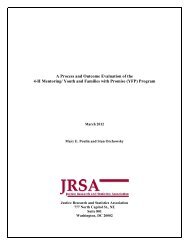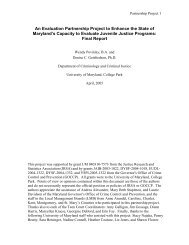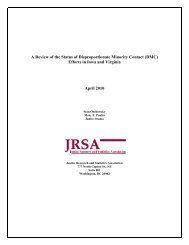Juvenile Justice System and Risk Factor Data - Illinois Criminal ...
Juvenile Justice System and Risk Factor Data - Illinois Criminal ...
Juvenile Justice System and Risk Factor Data - Illinois Criminal ...
You also want an ePaper? Increase the reach of your titles
YUMPU automatically turns print PDFs into web optimized ePapers that Google loves.
Detention data information<br />
<strong>Data</strong> collected for the Administrative Office of the <strong>Illinois</strong> Courts (AOIC) Annual Report to the<br />
<strong>Illinois</strong> Supreme Court <strong>and</strong> from the <strong>Juvenile</strong> Monitoring Information <strong>System</strong> (JMIS) were<br />
used to examine admissions to <strong>Illinois</strong> youth detention centers from 1997 to 2007.<br />
JMIS is a web-based management information system, managed by the University of <strong>Illinois</strong> that<br />
allows <strong>Illinois</strong> juvenile detention centers to electronically submit data <strong>and</strong> run reports. The 2007<br />
data extracted from JMIS can be separated by age, gender, race, <strong>and</strong> offense type for each<br />
admission. Most detention centers reported in 2007 to JMIS the number of admissions <strong>and</strong> the<br />
characteristics of the youth admitted. Although the Cook County <strong>Juvenile</strong> Temporary Detention<br />
Center did not report to JMIS in 2007, they provided the Authority with detention data for 2007.<br />
The Cook County <strong>Juvenile</strong> Temporary Detention Center began JMIS data entry in 2007.<br />
Detention facilities use internal offense hierarchies <strong>and</strong> only submit the most serious charge for<br />
which a youth is being detained. This charge is then grouped into specific offense categories by<br />
the Authority. Detention offense categories used were based on the <strong>Illinois</strong> Compiled Statutes<br />
<strong>and</strong> are detailed in Appendix F. The JMIS system makes a distinction for juveniles admitted to<br />
detention for a warrant, which can be issued for any type of crime. In most warrant detention<br />
admissions, the offense for which the warrant was issued is specified in JMIS. However, in some<br />
cases this is not possible <strong>and</strong> the offense is designated as a non-specific warrant admission. In<br />
these situations, a warrant offense designation in the JMIS system indicates that the juvenile was<br />
admitted on the basis of an outst<strong>and</strong>ing warrant, rather than the offense for which the warrant<br />
was issued.<br />
Detention admissions information was obtained from AOIC annual reports for 1997 through<br />
1999. During these years it is not possible to separate out detention admissions by age. Detention<br />
admissions information from 2000 to 2007 was obtained from JMIS. For these years, the<br />
numbers reported are only for detention admissions of youth between the ages of 10 <strong>and</strong> 16.<br />
Youth over age 16 can be detained in juvenile detention centers, but usually only in special<br />
circumstances. For this reason, detention admission rates were limited to only youth ages 10 to<br />
16 when possible. The Cook County <strong>Juvenile</strong> Temporary Detention Center provided the<br />
Authority with detention admissions information for 2000 through 2006 as they did not begin<br />
reporting to JMIS until 2007. They did not provide the ages of youth, so the total Cook County<br />
admissions numbers provided for 2000 to 2006 were used.<br />
37

















